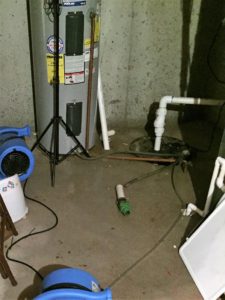Understanding Insurance Coverage for Sewage Cleanup
One of the most pressing concerns for homeowners facing sewage backup in their basement is whether their insurance policy covers the cleanup and repair costs. Understanding the specifics of your homeowners’ insurance policy is crucial for a stress-free recovery process.
Clarifying Homeowners’ Insurance Policies Regarding Sewage Backup
Standard homeowners’ insurance policies may not cover sewage backup without a specific endorsement. It’s essential to review your policy’s declarations page and check for any exclusions or limitations concerning sewage backup or water damage. Policies can vary significantly, so consider speaking with your insurance agent to ensure clarity and to purchase additional coverage if necessary.
Steps to Take to Ensure You’re Covered for Sewage Cleanup and Related Repairs
Ensuring that you’re covered requires a proactive approach:
- Review Your Policy: Frequently review your insurance policy to understand your coverage limits, deductibles, and any exclusions that might affect sewage backup incidents.
- Document Everything: In the event of sewage backup, document the damage thoroughly with photos and detailed notes. This evidence is crucial when filing an insurance claim.
- Contact Your Agent: As soon as possible, get in touch with your insurance agent to report the incident and seek guidance on the claims process.
- Understand the Claims Process: Familiarize yourself with the process of filing a claim, the timeline involved, and what documentation is required from your side.
By understanding your insurance policy and meticulously documenting the damage, you can make a well-informed claim and take a significant step towards a swift and efficient cleanup and restoration of your basement.
The Cost of Cleanliness: Expenses Associated with Sewage Cleanup
Dealing with a sewage mishap in your basement not only requires prompt and effective action to mitigate damage but also awareness of the financial implications. Navigating the costs of sewage cleanup is crucial for homeowners to understand the potential impact on their budget and to plan accordingly.
Breaking Down the Direct and Indirect Costs of Sewage Cleanup
When it comes to sewage cleanup, expenses can vary widely depending on the scale of contamination and the required restoration efforts. Direct costs are the immediate and tangible expenses involved in the cleanup process. These include:
- Professional cleaning and restoration service fees
- Costs for specialized equipment and supplies used in the cleanup
- Expenses related to the removal and disposal of contaminated materials
- Additional utility costs during the intensive cleanup process
Indirect costs, however, are often overlooked but equally important. They may encompass:
- Temporary accommodation costs if the home is uninhabitable during cleanup
- Loss of personal property that cannot be restored or decontaminated
- Potential health care expenses due to exposure to hazardous waste
- Long-term damage to property value if cleanliness standards aren’t met
Discussing Factors That Affect the Overall Replacement Cost
Several variables can influence the overall replacement cost during the sewage cleanup process, such as:
- Extent of Damage: More extensive contamination increases the workload and materials needed, thereby raising costs.
- Type of Materials Affected: Some materials may require specialized cleaning methods or may be irreplaceable, adding to expenses.
- Urgency of the Situation: Emergency services often come at a premium, with after-hours or rapid response fees.
- Geographical Location: Costs can vary depending on local market rates for professional services and supplies.
Understanding these variables can help homeowners better anticipate the expenses involved and take informed steps when contracting sewage cleanup services.
Education on the financial aspects of dealing with a sewage crisis is imperative. It empowers homeowners to make informed decisions and facilitates a more efficient path to restoring their property and peace of mind.
Expert Help: The Role of Professional Sewage Cleanup Services
Dealing with sewage in your basement is not only unpleasant but also potentially hazardous. In certain situations, enlisting the help of a professional sewage cleanup service is not only advisable but necessary for the safety of your home and family. Professional services are crucial in managing the problem effectively and ensuring that your living space is restored to a safe, hygienic state.
When to Hire Professionals and the Services They Provide
It is essential to call in professional help if:
- The sewage spill area is large or if the sewage has been standing for an extended period.
- You have any health concerns that may be aggravated by exposure to pathogens present in sewage.
- There is significant damage to your property and it’s beyond a simple clean-up.
Professional sewage cleanup services offer a range of solutions such as:
- Assessment and evaluation of the contamination extent.
- Removal and disposal of contaminated materials according to health regulations.
- Thorough cleaning, sanitization, and drying of affected areas.
- Executing necessary repairs and restoration work.
- Implementing measures to prevent future sewage backup issues.
The Benefits of Using Professional Equipment and Expertise
Professional cleanup teams come equipped with the right tools and expertise to handle hazardous materials safely and effectively. Here are some benefits they bring to the table:
- Industrial-grade equipment: Professionals have access to high-powered water extraction units, air scrubbers, and specialized cleaning agents that are more effective than common household tools.
- Expertise: Trained technicians understand the nuances of dealing with contaminated environments, ensuring that the cleanup process is thorough and complies with health regulations.
- Speed: With their experience, professionals can complete the job more quickly, minimizing the time your property is compromised.
Professional sewage cleanup services can transform a dire situation into a manageable and resolved issue, ensuring your basement is safe, clean, and odor-free. While the upfront cost might seem like an added burden, the long-term health and safety benefits far outweigh the expense.


